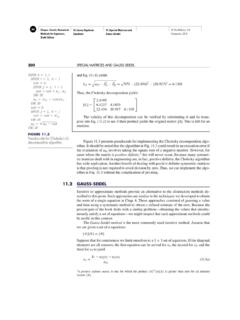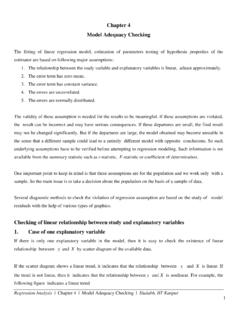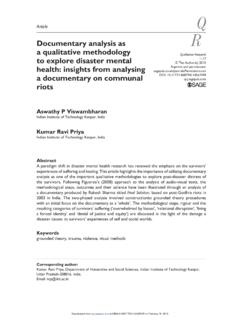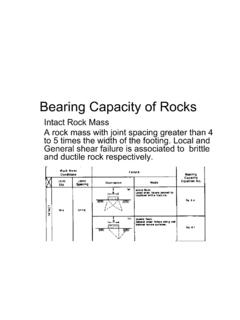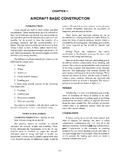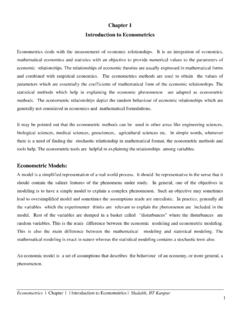Transcription of Statistical Methods
1 8 Statistical MethodsRaghu Nandan Sengupta and Debasis Basic Concepts of Data Analysis .. Probability .. Space and Events .. , Interpretations, and Properties of Probability .. -Field, Random Variables, and SomeImportantResults .. Estimation .. of Estimation .. MethodofMomentEstimators .. Estimators .. Linear and Nonlinear Regression Analysis .. Regression Analysis .. Bayesian Inference .. Regression Introduction to Multivariate Analysis .. JointandMarginalDistribution .. MultinomialDistribution .. Multivariate MultivariateExtremeValueDistribution .. MLEE stimatesofParameters(RelatedtoMNDOnly) .. Copula Theory .. Principal Component Analysis .. Factor Analysis .. Mathematical Formulation of Factor Analysis .. Estimation in Factor Analysis .. Principal Component Method .. Maximum Likelihood Method .. General Working Principle for FA.
2 Multiple Analysis of Variance and Multiple Analysis of Covariance .. Introduction to Analysis of Variance .. Multiple Analysis of Variance .. ConjointAnalysis .. 475413414 Decision Canonical Correlation Analysis .. Formulation of Canonical Correlation Analysis .. Standardized Form of CCA .. Correlation between Canonical Variates and Their Component TestingtheTestStatisticsinCCA .. Geometric and Graphical Interpretation of CCA .. Conclusions about CCA .. ClusterAnalysis .. ClusteringAlgorithms .. Multiple discriminant and Classification Analysis .. Multidimensional Scaling .. StructuralEquationModeling .. FutureAreasofResearch .. 501 References .. 502 ABSTRACTThe chapter of Statistical Methods starts with the basic concepts of data analysisand then leads into the concepts of probability, important properties of probability, limit theorems,and inequalities. The chapter also covers the basic tenets of estimation, desirable properties of esti-mates, before going on to the topic of maximum likelihood estimation, general Methods of moments,Baye s estimation principle.
3 Under linear and nonlinear regression different concepts of regressionsare discussed. After which we discuss few important multivariate distributions and devote sometime on copula theory also. In the later part of the chapter, emphasis is laid on both the theoreticalcontent as well as the practical applications of a variety of multivariate techniques like PrincipleComponent Analysis (PCA), Factor Analysis, Analysis of Variance (ANOVA), Multivariate analy -sis of Variance (MANOVA), Conjoint Analysis, Canonical Correlation, Cluster Analysis, MultipleDiscriminant Analysis, Multidimensional Scaling, Structural Equation Modeling, etc. Finally, thechapter ends with a good repertoire of information related to softwares, data sets, journals, etc.,related to the topics covered in this IntroductionMany people are familiar with the termstatistics. It denotes recording of numerical facts and figures,for example, the daily prices of selected stocks on a stock exchange, the annual employment andunemployment of a country, the daily rainfall in the monsoon season, etc.
4 However, statistics dealswith situations in which the occurrence of some events cannot be predicted with certainty. It alsoprovides Methods for organizing and summarizing facts and for using information to draw , the wordstatisticsis derived from the Latin wordstatusmeaningstate. For severaldecades, statistics was associated solely with the display of facts and figures pertaining to eco-nomic, demographic, and political situations prevailing in a country. As a subject, statistics nowencompasses concepts and Methods that are of far-reaching importance in all enquires/questionsthat involve planning or designing of the experiment, gathering of data by a process of experimen-tation or observation, and finally making inference or conclusions by analyzing such data, whicheventually helps in making the future finding through the collection of data is not confined to professional researchers. It is apart of the everyday life of all people who strive, consciously or unconsciously, to know mattersof interest concerning society, living conditions, the environment, and the world at large.
5 SourcesDownloaded by [Debasis Kundu] at 16:48 25 January 2017 Statistical Methods415of factual information range from individual experience to reports in the news media, governmentrecords, and articles published in professional journals. Weather forecasts, market reports, costs ofliving indexes, and the results of public opinion are some other examples. Statistical Methods areemployed extensively in the production of such reports. Reports that are based on sound statisticalreasoning and careful interpretation of conclusions are truly informative. However, the deliberate orinadvertent misuse of statistics leads to erroneous conclusions and distortions of Basic Concepts of Data AnalysisIn order to clarify the preceding generalities, a few examples are provided:Socioeconomic surveys:In the interdisciplinary areas of sociology, economics, and politicalscience, such aspects are taken as the economic well-being of different ethnic groups,consumer expenditure patterns of different income levels, and attitudes toward pendinglegislation.
6 Such studies are typically based on data oriented by interviewing or contactinga representative sample of person selected by Statistical process from a large populationthat forms the domain of study. The data are then analyzed and interpretations of the issuein questions are made. See, for example, a recent monograph by Bandyopadhyay et al.(2011) on this diagnosis:Early detection is of paramount importance for the successful surgicaltreatment of many types of fatal diseases, say, for example, cancer or AIDS. Becausefrequent in-hospital checkups are expensive or inconvenient, doctors are searching foreffective diagnosis process that patients can administer themselves. To determine the mer-its of a new process in terms of its rates of success in detecting true cases avoiding falsedetection, the process must be field tested on a large number of persons, who must thenundergo in-hospital diagnostic test for comparison.
7 Therefore, proper planning (designingthe experiments) and data collection are required, which then need to be analyzed for finalconclusions. An extensive survey of the different Statistical Methods used in clinical trialdesign can be found in Chen et al. (2015).Plant breeding:Experiments involving the cross fertilization of different genetic types ofplant species to produce high-yielding hybrids are of considerable interest to agriculturalscientists. As a simple example, suppose that the yield of two hybrid varieties are to becompared under specific climatic conditions. The only way to learn about the relativeperformance of these two varieties is to grow them at a number of sites, collect data ontheir yield, and then analyze the data. Interested readers may refer to the edited volumeby Kempton and Fox (2012) for further reading on this particular recent years, attempts have been made to treat all these problems within the framework of a uni-fied theory called decision theory.
8 Whether or not Statistical inference is viewed within the broaderframework of decision theory depends heavily on the theory of probability. This is a mathematicaltheory, but the question of subjectivity versus objectivity arises in its applications and in its interpre-tations. We shall approach the subject of statistics as a science, developing each Statistical idea as faras possible from its probabilistic foundation and applying each idea to different real-life problemsas soon as it has been data obtained from surveys, experiments, or any series of measurements are often sonumerous that they are virtually useless, unless they are condensed or reduced into a more suitableform. Sometimes, it may be satisfactory to present data just as they are, and let them speak forDownloaded by [Debasis Kundu] at 16:48 25 January 2017 416 Decision Sciencesthemselves; on other occasions, it may be necessary only to group the data and present results in theform of tables or in a graphical form.
9 The summarization and exposition of the different importantaspects of the data is commonly called descriptive statistics. This idea includes the condensation ofthe data in the form of tables, their graphical presentation, and computation of numerical indicatorsof the central tendency and are mainly two main aspects of describing a data set:1. Summarization and description of the overall pattern of the data bya. Presentation of tables and graphsb. Examination of the overall shape of the graphical data for important features, includingsymmetry or departure from itc. Scanning graphical data for any unusual observations, which seems to stick out fromthe major mass of the data2. Computation of the numerical measures fora. A typical or representative value that indicates the center of the datab. The amount of spread or variation present in the dataSummarization and description of the data can be done in different ways. For a univariate data,the most popular Methods are histogram, bar chart, frequency tables, box plot, or the stem and leafplots.
10 For bivariate or multivariate data, the useful Methods are scatter plots or Chernoff faces. Awonderful exposition of the different exploratory data analysis techniques can be found in Tukey(1977), and for some recent development, see Theus and Urbanek (2008).A typical or representative value that indicates the center of the data is the average value or themean of the data. But since the mean is not a very robust estimate and is very much susceptible tothe outliers, often, median can be used to represent the center of the data. In case of a symmetricdistribution, both mean and median are the same, but in general, they are different. Other than meanor median, trimmed mean or the Windsorized mean can also be used to represent the central valueof a data set. The amount of spread or the variation present in a data set can be measured using thestandard deviation or the interquartile ProbabilityThe main aim of this section is to introduce the basic concepts of probability theory that are usedquite extensively in developing different Statistical inference procedures.
